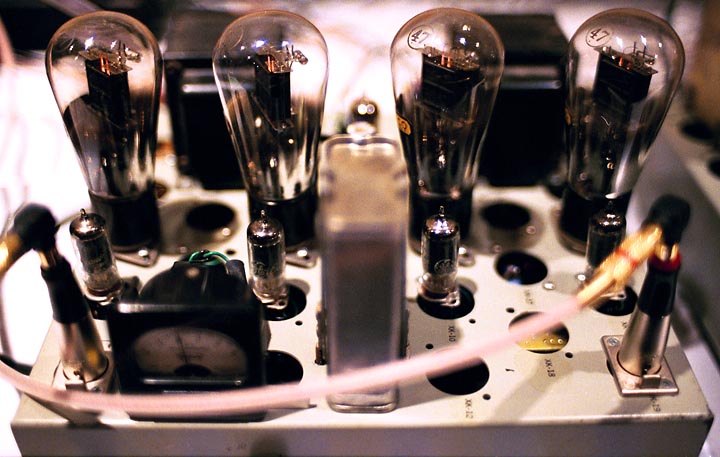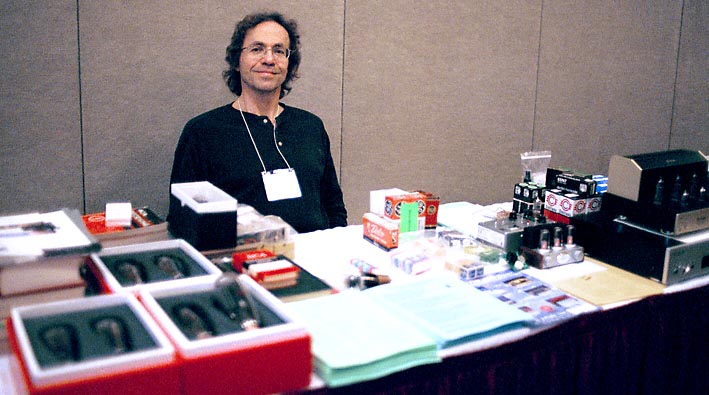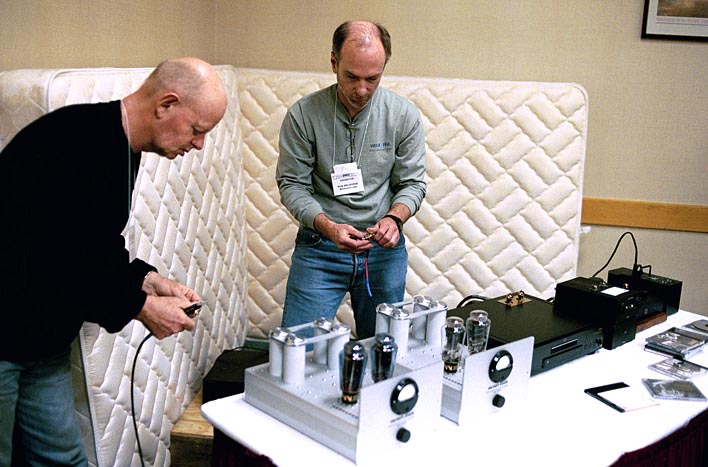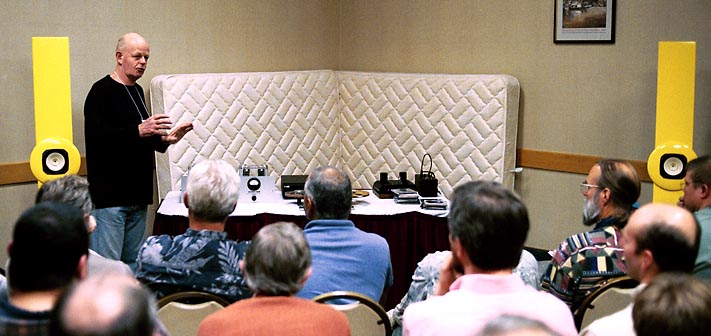
Gary Pimm's PP 47 all-pentode amplifier, almost life size
Vacuum Tube Valley VSAC 2003 Show Report

And now for something completely different. For those of you who don't know him, you have to realize that Gary Pimm has a rather subtle sense of humor. His most beautiful-sounding projects are frequently constructed out of the most homely ingredients imaginable - rather tongue-in-cheek when you discover the depth of engineering sophistication in the seemingly simple projects. This is an old Tektronix in-joke (Gary's still there after twenty-plus years, I was there for only nine).
The idea is to build a prototype of world-beating performance, entirely from materials found at your bench. One year at the Spectrum Analyzer business unit, there was a competition to build microwave receivers - good ones - out of coffee cans, so you could pick up HBO on a low-power microwave carrier transmitted from the Portland Hills. The RF engineers would aim their gizmos out the Building 58 windows and tune up the RF circuits while watching grainy pictures of pirated HBO. One day, one of the founders of Tektronix (Howard Vollum) walked by and saw the array of coffee-cans aimed out the windows of the second floor.
I watched with concern as he examined the extremely funky receivers - after all, these were pirate TV receivers, and he knew it as well as any of us did - and rather than scream and demand the immediate destruction of the receivers, he picked one up, analyzed how they worked, and gave the (world-class) microwave engineers a few tips how to improve the performance. And walked away with a little smile on his face.
That was the old Tektronix. I was stunned. Anyone that's ever worked in Big Corporate America knows how rare genuine engineering enthusiasm is. Howard, by what he did and didn't do that day, made it clear to all of us what he valued - on-the-edge engineering, first, last, and always. Again, this is the old Tektronix, back in the early Eighties.
Which gets us back to Gary Pimm. Unless you've worked for Tek or Hewlett-Packard, Gary's little jokes aren't obvious. Not only is his superb amplifier built from the cheeziest chassis imaginable, it's actually a good choice for quick prototyping. And the circuit, although seemingly obvious, is actually quite subtle, getting around the issue of HF distortion from Miller capacitance by simply avoiding triode operation altogether. The fact that it directly flies in the face of the VSAC "direct-heated-triodes in single-ended are always best" convention is just a bonus.
In fact, the PP47 is actually a video amplifier with very low HF distortion, with the bandwidth limited only by the output transformer (which are, believe it or not, from old Fisher receivers bought at garage sales around Portland). Speaking of garage sales, Gary is the only guy I know who's managed to find a pair of mint Electro-Voice T350 tweeters in an old console for less than $50. He just has the knack, that's all I can say.

Here's the guy I write for, Charlie Kittleson, publisher of Vacuum Tube Valley magazine. Although many of you know about the magazine, Gary Pimm and I found out on our visit to Lakeport, California that "CK" has not one, but two radio shows, plays in a rock-and-roll and blues band, and probably has a literal ton of NOS vacuum-tube goodies of all kinds, some of which are on the table in the picture. Sheesh! Talk about energy!
Since he's a pro musician, he approached the vacuum-tube scene from a different angle than the audiophile crowd, or the usual engineering-geek perspective. Charlie joined forces with Eric Barbour and John Atwood, rented a little office in Santa Clara, and started a magazine. All they needed was a name: they looked across the busy street to the Intel headquarters, thought a moment about Santa Clara's nickname (Silicon Valley), and the name for the magazine was obvious: Vacuum Tube Valley. Several years later, CK and Eric are in Lakeport, California, a lakeside resort town 100 miles north of the Big City, John is in Nevada, and yours truly is Tech Editor for VTV.

Here's the world debut of the Allen Wright Allen's DPA-300B, powering Cain & Cain Abby speakers. The sound, as you might expect, was fast, decisive, and definitely not the stereotype of "romantic tube sound" that mainstream high-end folks expect. Vintage tube amps - and the modern high-end amps that copy the old circuits - are very different animals than the new breed of direct-heated-triode amplifiers. That's one of the real advantages of going to the VSAC compared to the mainstream shows like the CES or the Stereophile show - you get to hear, in one medium-sized hotel, the best current examples of the triode art - and meet fun people too.

High-efficiency speakers are the traditional favorite of the VSAC, and the Cain & Cain speakers met the bill and then some. They have the advantage of revealing amplifier "flavors" more readily than conventional audiophile low-efficiency speakers. Note sophisticated room treatment system with "Do Not Remove Under Penalty of Federal Law" tag on the right side of the picture - this ain't mainstream high-end, folks. Only at the VSAC.
Page Six
All Text and Photographs © 2003 Lynn Olson.